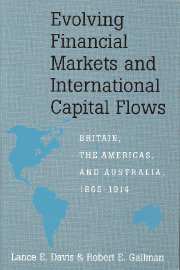 Evolving Financial Markets and International Capital Flows
Evolving Financial Markets and International Capital Flows Book contents
- Frontmatter
- Contents
- 1 Institutional invention and innovation: Foreign capital transfers and the evolution of the domestic capital markets in four frontier countries: Argentina, Australia, Canada, and the United States, 1865–1914
- 2 The United Kingdom
- 3 International capital movements, domestic capital markets, and American economic growth, 1865–1914
- 4 Domestic savings, international capital flows, and the evolution of domestic capital markets: The Canadian experience
- 5 Domestic saving, international capital flows, and the evolution of domestic capital markets: The Australian experience
- 6 Argentine savings, investment, and economic growth before World War I
- 7 Lessons from the past: International financial flows and the evolution of capital markets, Britain and Argentina, Australia, Canada, and the United States before World War I
- 8 Skipping ahead: The evolution of the world's finance markets 1914–1990 – A brief sketch
- 9 Lessons from the past
- Bibliography
- Index
9 - Lessons from the past
Published online by Cambridge University Press: 18 August 2009
- Frontmatter
- Contents
- 1 Institutional invention and innovation: Foreign capital transfers and the evolution of the domestic capital markets in four frontier countries: Argentina, Australia, Canada, and the United States, 1865–1914
- 2 The United Kingdom
- 3 International capital movements, domestic capital markets, and American economic growth, 1865–1914
- 4 Domestic savings, international capital flows, and the evolution of domestic capital markets: The Canadian experience
- 5 Domestic saving, international capital flows, and the evolution of domestic capital markets: The Australian experience
- 6 Argentine savings, investment, and economic growth before World War I
- 7 Lessons from the past: International financial flows and the evolution of capital markets, Britain and Argentina, Australia, Canada, and the United States before World War I
- 8 Skipping ahead: The evolution of the world's finance markets 1914–1990 – A brief sketch
- 9 Lessons from the past
- Bibliography
- Index
Summary
Introduction
In 1999 the international capital market, although still not a perfect market by an economist's definition of the term, is certainly much broader and almost certainly more efficient than it was two and a half decades ago. In fact, its breadth and efficiency have caused a number of highly respectable economists to suggest arguments that almost certainly would, only recently, have been considered heresy: namely, that “perfection” carries with it some serious problems and that, at times, it may constitute a considerably less than perfect institutional structure. There have been financial crises in Mexico and Latin America in the early 1980s, and again in the mid-1990s. Since the mid-1990s the Japanese miracle has become a bad dream. In 1998 and 1999 a major Asian crisis – a crisis that has already begun to impact Brazil and threatens to engulf markets throughout the western world – has had a dramatic effect on the financial infrastructure of developing Asian countries, countries like Korea, Thailand, Indonesia, and Malaysia. Given these apparently continuing problems, could policy makers have learned anything from the history of the world's financial markets in the years leading up to World War I?
- Type
- Chapter
- Information
- Evolving Financial Markets and International Capital FlowsBritain, the Americas, and Australia, 1865–1914, pp. 875 - 925Publisher: Cambridge University PressPrint publication year: 2001
